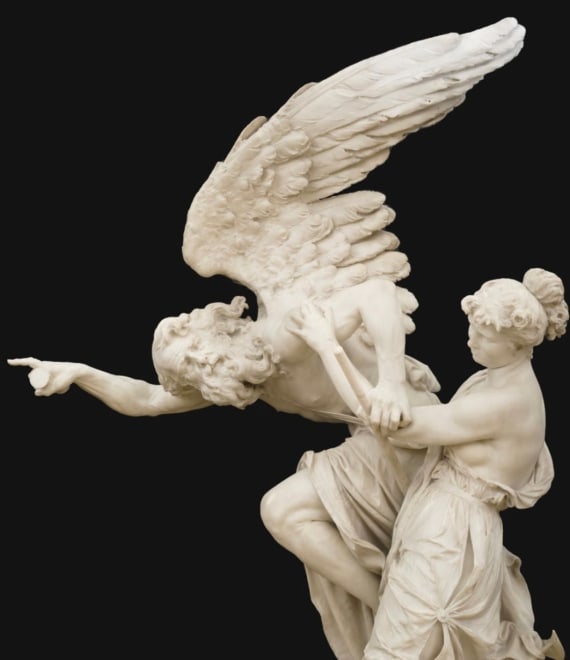base: 29 1/2 by 35 1/2 (75 by 90 cm.)
Provenance
Sale, Sotheby’s, London, 11 November 2008, lot 82
Private collection, California (acquired at the above sale)Catalogue note
Donato Barcaglia (1849-1930) is considered one of the most important 19th century Italian sculptors, and Beauty Holding back Time is unquestionably his masterpiece. Carved in marble on a monumental scale (226 by 150 cm.), Barcaglia has personified Beauty as a young woman, who tries to resist the inevitable decline into old age. Her nemesis is Father Time (with his dramatic flair, a figure worthy of the Baroque), who charges forward with unstoppable force. He holds an hourglass in his hand and points outward, while staring back at his companion. Father Time symbolizes that aging is inevitable and time only moves forward. His “victim” however, not wanting to accept this stark reality, attempts to pull him back. The dynamic pose of Father Time almost defies gravity; with his size and heft, he appears on the brink of toppling the entire marble.
Barcaglia’s earliest version of Beauty Holding back Time was first exhibited in Florence in 1875 where it met with critical acclaim and tremendous accolades. A review in the L’Italia Artistica called it a ‘wonderful success… equal in its importance for the subject as much as for the movement of the figures and in the expressions and life. Beauty is represented at her most vigorous age or rather the moment at which she starts to decline and to feel the effects of time that is running away. With her hands she tries to stop time whilst with her look, somewhere between tearful and seductive, she tries to cajole him to listening to her pleas…and with an ironic smile he makes her understand that any attempt is futile.’
Beauty Holding back Time crossed the Atlantic in 1876, when it was featured at the Philadelphia Centennial Exhibition. Winning a Gold Medal at the fair, it was acquired by the Museo Revoltella in Trieste. Most likely due to the huge popularity of his first sculpture, Barcaglia made a second version in 1884, which is the present work. While the exact circumstances of the acquisition are unknown, the sculpture eventually ended up in the collection of the Swinfen Broun family in Staffordshire, who may have seen it in one of the exhibitions that Barcaglia organized in London in 1881 and 1888.




